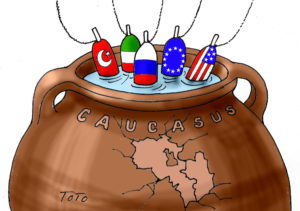 By Edmond Azadian
By Edmond Azadian
PART l
Armenia seems to have been destined by history to be located in a geographic area where major political interests and empires clash and where the local population is destined to be beholden perpetually to the consequences of wars, ethnic cleansing and deportations.
Historic accidents have rendered Armenia a landlocked country and therefore subject to pressures, intimidations and blockades. After World War I, had the Allies made good on their promises, Armenians would have had home rule in Cilicia, with a seaport at Alexandretta (Iskenderun). Also, had the Treaty of Sevres been implemented (1920), Wilsonian Armenia had the Port of Trabizon designated as an entrée to Europe and the rest of the world. But with the loss of those opportunities, Armenia has remained vulnerable to outside threats and isolation.
When Armenia was absorbed into the Soviet Union, those geographic limitations lost their significance as the Republic had access to the advantages to which the Union itself was entitled.
But history came to haunt Armenia as soon as it regained its independence and it restored its sovereignty over a portion of its historic territory.









